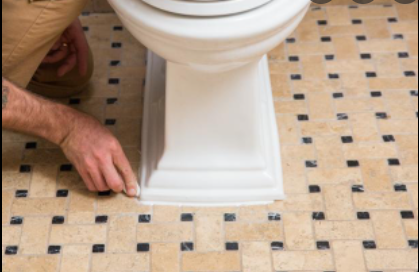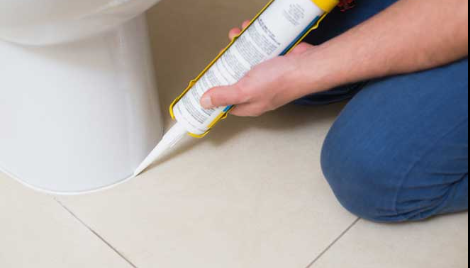Caulking around the toilet is a divisive matter that elicits different reactions from plumbers and clients. But should you caulk around a toilet? When it comes down to it, the pros of caulking around your toilet outweigh the cons. As a result, caulking your commode is the smart thing to do.
Professional plumbers often decide whether to caulk your toilet or not based on their personal views. If you decide to install the toilet yourself, you should consider the advantages and disadvantages of caulking. Continue reading to understand the pros and cons of caulking around your commode.
Why You Should Not Caulk Around Your Toilet
If you intend to caulk around your commode during installation, you should know that the practice has several disadvantages. Here are the cons of caulking around your toilet:
Hidden Leaks
The last thing you want on your toilet is a hidden leak. Once you caulk your toilet, you are not likely to notice a leak at any point in the future. However, you might notice water seepage if the leak is large enough. Caulking the toilet base often traps water inside and contributes to further damage over time.
Harder Repairs
If you choose to caulk around your commode, brace yourself for harder repairs in the future. The caulk at the toilet base translates into an additional barrier that you have to get rid of during repairs. Removing the caulk can lead to floor damage if it is not done properly. Caulking may also leave stains on the floor if a professional plumber does not do it.
Wax Seals
If you want to caulk around your porcelain throne, you must include a wax seal to curtail any leakages. This means that you will incur extra costs to caulk your toilet. The seal is usually made of wax and has a significantly limited function compared to caulking. Nonetheless, wax seals allow you to meet plumbing regulations.
Why You Should Caulk Around Your Toilet
The pros of caulking around your commode outweigh the cons. Here are the benefits of caulking around your toilet:
Secures the Commode in Place
Using caulk secures your commode to the bathroom floor. Caulking also gives your toilet an extra level of sturdiness that makes your user experience worry-free. It is worth noting that using an unstable toilet is dangerous and can damage the toilet. A properly secured toilet cannot wriggle even when extra heavy individuals sit on it.
Aesthetics
An aesthetically pleasing bathroom is every homeowner’s dream. After installation, the seams around the base of your commode can be an eyesore to bathroom users. Caulking around the toilet base solves this problem by covering the seams. It would be best to consider hiring a professional plumber for optimal results.
Prevents Molds and Foul Smell
Caulking around the toilet ensures that water from outside does not enter under the toilet and get trapped. The trapped water presents a significant problem because it is difficult to get rid of expeditiously. Notably, the water creates mold and a foul smell. The mold can present a health problem, while the foul smell makes using the toilet an unpleasant experience.
Caulking around the toilet rim seals any gaps and prevents liquids from seeping into the cavity beneath the toilet. Some professional plumbers often leave an inch of the toilet’s base without caulk to make it easier to notice any leaks. However, you should ensure that the unsealed section is at the end of the floor’s sloping gradient.
Complying With Plumbing Codes
Whether you are installing your toilet in your home or business establishment, it is best to adhere to existing plumbing codes. Even though the enforcement of plumbing regulations is not as strict as it should be, it is important to prepare for any eventuality. Notable plumbing regulations include:
- The International Plumbing Regulation of 2012. The regulation requires plumbers to seal joints between fixtures and floors.
- The Uniform Plumbing Regulation. The regulation necessitates plumbers to make joints watertight.
Keeping Out Bugs
Bugs love dark spaces in the household environment. The cavity beneath the toilet bowl is a perfect space for bugs to hide and reside. Common bugs that hide in dark spaces include cockroaches, ants, and water bugs. Caulking the toilet base makes it difficult for bugs to move in and out of the cavity beneath the toilet bowl.
Uneven Surfaces
If your bathroom floor is uneven, caulking is a perfect solution for the problems presented by uneven surfaces. One such problem is the toilet’s instability. Caulking the toilet gives it much-needed stability and curtails potential damage.

Should You Caulk Around A Toilet to Repair a Leak?
If you notice that your toilet bowl is leaking at the base, you should not employ caulk to solve the problem. Caulking the toilet base cannot fix the leakage but only compounds the problem. It is worth noting that caulking traps water in the cavity beneath the toilet bowl, resulting in floor damage.
Catastrophic floor damage would require you to renovate your bathroom or even purchase a new toilet. As such, caulking your toilet base to fix a leakage could translate into high long-term costs. If you notice a leak, you should first fix it before caulking around your commode.
What Kind of Caulk Should You Use Around Your Toilet?
If you are looking for caulk in the marketplace, you should know that the best brand is the one that has 100% silicone. Notably, silicone is a waterproof substance that prevents water from seeping into the cavity beneath the toilet bowl. Silicone-based caulk does not disintegrate when it comes into contact with water. As such, you should not worry about mopping the areas around the base of your commode.
Bottom Line
The issue of caulking around the toilet evokes different reactions from clients and plumbers alike. If you intend to caulk around your toilet, you should consider the pros and cons of caulking. Moreover, the conditions in your bathroom should inform your decision. For instance, caulking is ideal for stabilizing your toilet if your bathroom floor is uneven.

Judy Battista is an interior designer who holds a bachelor’s degree in interior design from Cornell University — Ithaca, NY. Her passion for home improvement and interior design has contributed to her extensive knowledge of everything bathroom remodeling and general interior design. Judy often publishes home décor articles on several websites, including Sprucetoilets.com, Sprucebathroom.com, and Mybesuitedhome.com. She also contributes to various interior design magazines. As a skilled interior designer, Judy Battista is well versed in computer-aided design (CAD) and other technologies used in the interior design space.
